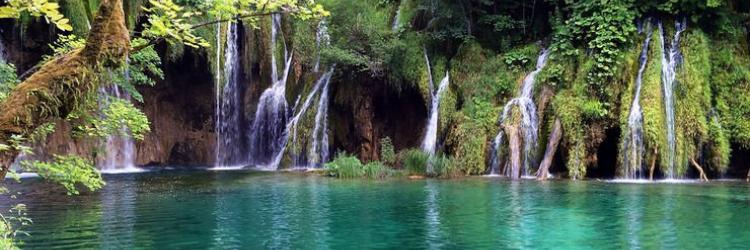Travel destinations Comments: 3 Apr 30, 2018
Plitvice Lakes National Park is one of the oldest national parks in Southeast Europe and the largest national park in Croatia. The national park is world-famous for its lakes arranged in cascades, and 16 lakes can be seen from the surface.
The national park was founded in 1949 and is situated in the mountainous karst area of central Croatia.
The Plitvice Lakes originate in the south of the park area at the confluence of Bijela Rijeka (English White River) and Crna Rijeka (English Black River). These rivers originate south of the municipality of Plitvički Ljeskovac and unite at one of the bridges in this village.
In 1979, Plitvice Lakes National Park was added to the UNESCO World Heritage register.
The protected area extends over 296.85 square kilometres (73,350 acres). About 90% of this area is part of Lika-Senj County, while the remaining 10% is part of Karlovac County. The lakes are separated into an upper and lower cluster formed by runoff from the mountains, descending from an altitude of 636 to 503 m (2,087 to 1,650 ft) over a distance of some eight km, aligned in a south-north direction. The lakes collectively cover an area of about two square kilometres (0.77 square miles), with the water exiting from the lowest lake forming the Korana River.
The name Plitvice was first mentioned in a written document in 1777 by Dominik Vukasović, the priest of Otočac. This name was designated due to natural phenomena that have created the lakes. Nature formed shallow basins (Croatian pličina or plitvak, plitko means shallow), which have been filled with water. For centuries, water has changed the limestone and thus the landscape of this area.
The overall water body area of the national park is about 2 km2 (0.77 sq mi). The two largest lakes, Prošćansko jezero and Kozjak, cover about 80 percent of the overall water body area. These lakes are also the deepest, with a depth of 37 and 47 metres (121 and 154 ft) respectively. On Lake Kozjak, low-noise and ecologically-friendly electric boats are being used. None of the other lakes in the park exceeds 25 metres (82 feet) in depth. The altitude drop from the first lake to the last is 133 metres (436 feet).
The 16 lakes that can be seen from the surface are grouped into the 12 Upper Lakes (Gornja jezera) and the four Lower Lakes (Donja jezera).
The Plitvice Lakes national park is heavily forested, mainly with beech, spruce, and fir trees, and features a mixture of Alpine and Mediterranean vegetation. It has a notably wide variety of plant communities, due to its range of microclimates, differing soils and varying levels of altitude.
Scientists have so far listed 1,267 different plants out of 109 species that can be found within the area of the national park. 75 plants are endemic, which means that they have first been defined and classified in this area of the world or not far from it.
For reasons of the poor industrial development of this region and early introduced protection measures, a nearly untouched landscape has been preserved. In the partially primeval beech and fir forests various rare species, such as the brown bear have survived. At the Plitvice Lakes, all species continue to exist that have already existed before the coming of man. This is a rare case worldwide.
The development of tourism
In 1861, an accommodation for travelers was erected at Velika Poljana. The local population called this accommodation the Emperor's house, since imperial military officers used to reside in this location. In 1890, the tradesman Ante Devčić from Senj built the first hotel with a restaurant at Prošćansko jezero.
During the 1960s, a modern road connection to the Plitvice Lakes was constructed, which led to increasing traffic volumes. During these years, several hotels and other objects were erected according to innovative plans of Croatian architects. During the 1980s, tourism was booming in Yugoslavia. Plitvice Lakes National Park soon became one of Yugoslavia's most popular tourist attractions.
Legend about the origin of the Plitvice Lakes
This whole place in some maps is still called the Devil's Garden, due to its location and history. According to legend, the Plitvice lakes were created after a long drought. People, animals and lakes craved for water.
People prayed and prayed. Then in the valley appeared the the goddess, the Black Queen with her magnificent retinue; She took pity on the people, and with strong winds and thunders in the country has finally rained. It was raining so long as the water level has grown enough to form lakes.
You can easily reach to Plitvice Lakes National Park from all major cities in Croatia:


 RS
RS  ME
ME  HR
HR  BA
BA  RU
RU  MK
MK  AL
AL  ES
ES  DE
DE  IT
IT  CN
CN  NL
NL  SE
SE  FR
FR 






Write a comment